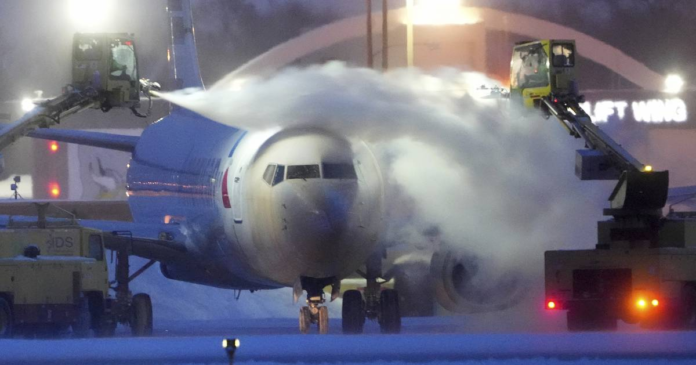An American Airlines plane is de-iced as high winds whip around 7.5 inches of new snow at Minneapolis-St. Paul International Airport Thursday, Dec. 22, 2022. Temperatures plunged far and fast Thursday as a winter storm formed ahead of Christmas weekend, promising heavy snow, ice, flooding and powerful winds across a broad swath of the country and complicating holiday travel. (David Joles/AP)
A battering winter storm left nearly 2 million homes and businesses without power across the United States on Saturday, as millions more people were left to worry how the prospect of further outages would effect holiday and travel plans.
The blinding blizzards, freezing rain and frigid cold that enveloped much of the country knocked out power to an estimated 1.7 million households and businesses, while major electricity grid operator warned the 65 million people it serves across the eastern U.S. that rolling blackouts might be required.
Advertisement
Across the country, officials have attributed at least 10 deaths of exposure, storm damage and car crashes on icy and snow covered roads.
Pennsylvania-based PJM Interconnection said power plants are having difficulty operating in the frigid weather and has asked residents in 13 states to refrain from unnecessary use of electricity. The Tennessee Valley Authority, which provides electricity to 10 million people in Tennessee and parts of six surrounding states, directed local power companies on Saturday to implement planned interruptions to “ensure power system reliability.”
Advertisement
Across the six New England states, almost 400,000 electric customers remained without power on Saturday morning, with some utilities warning it could be days before power is restored. In North Carolina, more than 415,000 customers were without power, according to poweroutage.us.
The emergency call for system-wide conservation from PJM Interconnection advised residents to set thermostats lower than usual, to postpone use of major appliances like stoves and dishwashers and to turn off nonessential lights. Commercial and industrial power users have also been asked to cut back. Utility officials said simultaneous increased demand across its electric system came as some power plants are having difficulty operating in the extreme cold. They warned of rolling blackouts.
“It’ll be short-lived, we’ll do everything we can to prevent it, but it is a real possibility,” said Mike Bryson, PJM’s senior vice president for operations. It covers all or parts of Delaware, Illinois, Indiana, Kentucky, Maryland, Michigan, New Jersey, North Carolina, Ohio, Pennsylvania, Tennessee, Virginia, West Virginia and Washington, D.C.
Across the country, the storm forced the closure of highways and crashes, exposure and storm damage have killed at least 10 people, officials said.
Four died in a massive pileup involving some 50 vehicles on the Ohio Turnpike. A Kansas City, Missouri, driver was killed Thursday after skidding into a creek, and three others died Wednesday in separate crashes on icy northern Kansas roads.
A woman in Vermont died in a hospital Friday after a tree broke in the high winds and fell on her house. Police in Colorado Springs said they found the dead body of a person who appeared to be homeless as subzero temperatures and snow descended upon the region.
Adding to the woes were power outages that by early Saturday were still affecting more than 1.7 million homes and businesses, according to the website PowerOutage, which tracks utility reports.
The storm was nearly unprecedented in its scope, stretching from the Great Lakes near Canada to the Rio Grande along the border with Mexico. About 60% of the U.S. population faced some sort of winter weather advisory or warning, and temperatures plummeted drastically below normal from east of the Rocky Mountains to the Appalachians, the National Weather Service said.
Advertisement
Freezing rain coated much of the Pacific Northwest in a layer of ice, while people in the Northeast faced the threat of coastal and inland flooding.
The frigid temperatures and gusty winds were expected to produce “dangerously cold wind chills across much of the central and eastern U.S. this holiday weekend,” the weather service said, adding that the conditions “will create a potentially life-threatening hazard for travelers that become stranded.”
“In some areas, being outdoors could lead to frostbite in minutes,” it said.
As millions of Americans were traveling ahead of Christmas, more than 5,700 flights within, into or out of the U.S. were canceled Friday, according to the tracking site FlightAware. While in Mexico, migrants camped near the U.S. border in unusually cold temperatures as they awaited a U.S. Supreme Court decision on pandemic-era restrictions that prevent many from seeking asylum.
Forecasters said a bomb cyclone — when atmospheric pressure drops very quickly in a strong storm — had developed near the Great Lakes, stirring up blizzard conditions, including heavy winds and snow.
Even people in Florida were braced for unusually chilly weather as rare freeze warnings were issued for large parts of the state over the holiday weekend.
Advertisement
South Dakota Gov. Kristi Noem said she was deploying the National Guard to haul timber to the Oglala Sioux and Rosebud Sioux tribes and help with snow removal.
“We have families that are way out there that we haven’t heard from in two weeks,” said Wayne Boyd, chief of staff to the Rosebud Sioux president.
Calling it a “kitchen sink storm,” New York Gov. Kathy Hochul declared a state of emergency. In parts of New York City, tidal flooding inundated roads, homes and businesses Friday morning.



